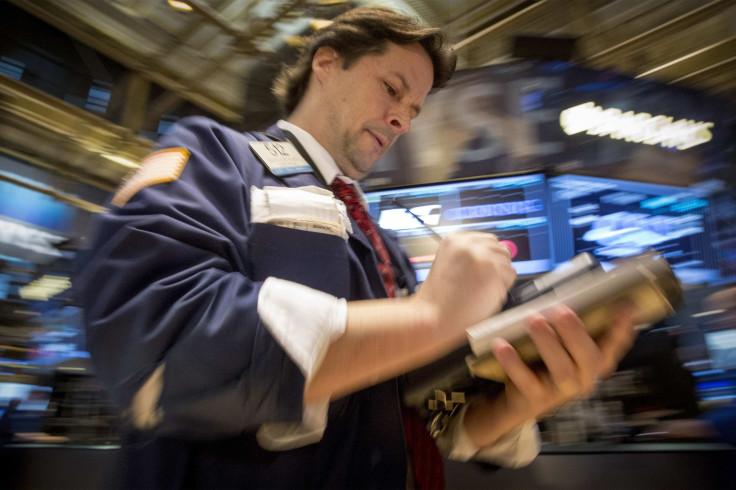Dow Jones Industrial Average Plunges More Than 200 Points After Crude Oil Inventories Surge To 80-Year High

U.S. stocks dropped Wednesday, with the Dow Jones Industrial Average tumbling more than 200 points, after crude oil inventories surged to an 80-year high. The global markets were also weighed down on an earnings miss from investment giant JPMorgan Chase & Co. and a Commerce Department report showing that U.S. retail sales missed forecasts. JPMorgan's shares fell more than 4 percent after the company's earnings release.
On Wednesday morning, the Dow Jones Industrial Average, which measures the share prices of 30 large industrial companies, dropped 215 points, or 1.22 percent, at 17,398.16; the S&P 500 stock index lost 21.50 points, or 1.06 percent, at 2,001.59. The Nasdaq Composite fell 36.81 points, or 0.79 percent, at 4,624.78.
Crude Oil Inventories Surge To 80-Year High
Oil prices extended their rout Wednesday, continuing to fall after U.S. commercial crude oil inventories rose by 5.4 million barrels from the previous week. At 387.8 million barrels, U.S. crude oil inventories are at their highest level (for this time of year) in at least 80 years, the U.S. Energy Information Administration said Wednesday.
Crude prices also fell on global growth concerns after the World Bank cut its outlook for global growth Tuesday. “Worryingly, the stalled recovery in some high-income economies and even some middle-income countries may be a symptom of deeper structural malaise,” Kaushik Basu, World Bank chief economist and senior vp, said in a statement Tuesday.
Trade flows are likely to remain weak in 2015, the World Bank said. Since the global financial crisis, global trade has slowed significantly, growing by less than 4 percent in 2013 and 2014, well below the pre-crisis average growth of 7 percent per year.
West Texas Intermediate (WTI) crude, the benchmark for U.S. oil prices, added 0.98 percent Wednesday to $46.34 per barrel, for Feb. 15 delivery, on the New York Mercantile Exchange. Brent crude, the global benchmark for oil prices, edged up 46.75 percent Wednesday, to $45.75 per barrel, for Feb. 15 delivery, on the London ICE Futures Exchange.
U.S. Retail Sales Post Largest Decline in 11 Months
Data Wednesday showed retail sales dropped last month, surprising economists after consumer spending was expected to jump as gas prices tumbled across America. Retail sales fell 0.9 percent last month after a 0.4 percent increase in November, the largest decline in 11 months, the Commerce Department said Wednesday. Economists had expected December retail sales to decline 0.10 percent after rising 0.7 percent in November, according to Reuters data.
But economists don’t think the decline in retail sales is the start of something “pernicious,” according to Paul Diggle, economist at Capital Economics. “Admittedly, average hourly earnings also fell in December. But a collapse in activity doesn’t fit with the strength of employment growth last month and the recent surge in consumer confidence to multiyear highs,” Diggle said in a research note Wednesday.
JPMorgan's Q4 Profit Misses Forecasts, Shares Drop More Than 4%
Kicking off earnings season for the financial sector Wednesday was JPMorgan Chase and Wells Fargo & Co. JPMorgan, the biggest U.S. bank by assets, said fourth-quarter net profit dropped 6.6 percent due to $1.1 billion in legal costs, sending shares tumbling 4.20 percent to $56.43.
Meanwhile, Wells Fargo, the fourth-largest U.S. bank, posted quarterly earnings Wednesday in line with Wall Street expectations as the bank posted a profit of $5.71 billion, or $1.02 per share, on revenue of $21.44 billion. Following the report, shares of Wells Fargo dropped 1.08 percent Wednesday to $51.29.
Federal Reserve Looks For Signs To Act On Interest Rates. "Beige Book" Due Later Today
Economists are looking ahead as the U.S. Federal Reserve is scheduled to release its “Beige Book” at 2 p.m. EST Wednesday. The central bank publishes the report eight times a year, highlighting the current condition of the U.S. economy within the central bank's 12 districts. Market professionals will be analyzing the Fed’s Beige Book for any indication on when the central bank may raise interest rates, which are currently at historic lows. Most economists expect the Fed to hike rates sometime in mid-2015.
“While fee income and pockets of loan growth could bump up top lines some from the previous quarter, analysts say the prolonged low-interest-rate environment continues to pressure net interest margins and likely will keep income levels generally in check,” Chris Vanderpool and Kevin Dobbs, analysts at SNL Financial, said in a note Tuesday.
© Copyright IBTimes 2025. All rights reserved.






















